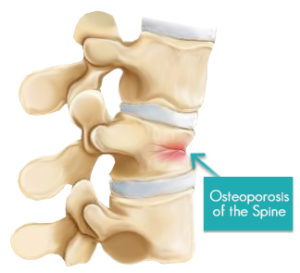What is Spinal Osteoporosis?

Osteoporosis is a bone density condition. It causes structural deterioration of bone tissue. Therefore, causing an increased risk of fractures. The onset of osteoporosis does not cause any pain or symptoms. For this reason, it is called a silent disease. However, when you age, this may cause pain and limited mobility (from an increase of fractures.)
If you suspect osteoporosis of the spine, you must get screened. Then, if you have been identified as a risk, a bone density test will be ordered. However, since women are more susceptible than men, it is recommended that women over the age of 60 get screened. Men are also recommended for a screen, although over the age of 70.
Symptoms & Signs of Osteoporosis of the Spine:
As mentioned previously, in the early stages of the disease, there will be no symptoms. However, when pain does occur, it is from bone or muscle aches in the lower back. Then, as time passes, the pain becomes more intense. Typically, intensifying to sudden sharp pain. At times, it can even last several months!
When untreated and undiagnosed, the disease can cause sudden and painful spine compression fractures. Sometimes, a spinal fracture may cause your spine to curve forward. When this occurs, it is called kyphosis. However, in severe cases, the nervous system an cause symptoms, such as:
- Weakness
- Tingling
- Numbness
- Difficulty walking
- Balance issues
Causes & Risk Factors:
Spinal osteoporosis is primarily caused by the natural aging process. As as we age, changes to the bone mass and structure often affect the bone interior, called cancellous. Also, it can affect the outer bone area, called cortical bone.
Throughout the aging process, the breakdown of bone becomes quicker than it can rebuild. Therefore, leading to loss of bone mass and integrity of the bone structure. This causes the bones to weaken and become more likely to fracture. In fact, women who are post-menopausal more likely to get diagnosed with spinal osteoporosis.
Additional causes of osteoporosis include:
- Family History: If someone in your family has or had osteoporosis, you’re more at risk.
- Gender: Women are simply more likely to develop osteoporosis.
- Ethnicity: White and Asian people are more likely to be affected by osteoporosis than black or Hispanic people, but this does not mean that black or Hispanic people are not at risk.
There is also a medical condition that can cause osteoporosis, such as:
Intestinal problems. Intestinal problems can interfere with absorbing calcium and vitamin D. Therefore, making it harder for your body to regenerate bones. Inflammatory Bowel Disease is an example.
Kidney problems. Kidney issues can cause calcium loss, upsetting the balance of bone loss and growth.
Parathyroid and thyroid problems. Hyperparathyroidism causes your body to create too much parathyroid hormone (PTH). Therefore, leading to bone loss. Hyperthyroidism puts too much of the thyroid hormone in your body, potentially weakening your bones.
Nutrient absorption problems. People with celiac disease have trouble absorbing nutrients like calcium and vitamin D, and without those, it’s harder to maintain healthy bones.
Treatment for Osteoporosis of the Spine:
When we talk about treatment for osteoporosis, it usually involves lifestyle changes. As an example, exercise, diet, and medications. In fact, certain bisphosphonate medications can slow down the process of bones breaking down.
Bisphosphonate medications, such as:
- Alendronate
- Ibandronate
- Risedronate
- Zoledronic acid
Exercise:
Regular exercise will help maintain bone density. It will also provide overall muscle strengthening that can reduce falls. Weight-bearing exercises are recommended, such as:
- Walking
- Going on a short hike
- Jogging
- Climbing stairs
- Pilates
- Yoga
Diet & Nutritian:
Vitamin D and calcium are a vital part of an osteoporosis sufferer’s diet. Certain nutrients are needed daily, such as:
Calcium
An increased amount of calcium is also critical. This can be found in dairy products, such as milk, cheese, and yogurt. Sometimes, a supplement will be recommended, however. Additionally, leafy greens are a great way to get calcium. You must watch your calcium intake, though. Too much can be damaging and cause other health conditions.
Vitamin D
Someone with osteoporosis needs to take Vitamin D. This is because the body needs this to absorb calcium. Supplements are typically recommended due to the high amounts found in some foods. Depending on your specific dietary needs will determine how much is needed.
Surgical Treatment:
After all conservative options are exhausted, surgery will be considered, such as:
Spinal Fusion. This procedure might be recommended by your physician if you have severe osteoporosis of the spine. Spinal fusion permanently connects two or more vertebrae in your back to improve stability.
If you are experiencing Osteoporosis pain, call us at 888-409-8006. Our offices are conveniently located in South Florida; Boca Raton, Deerfield Beach & Plantation.
